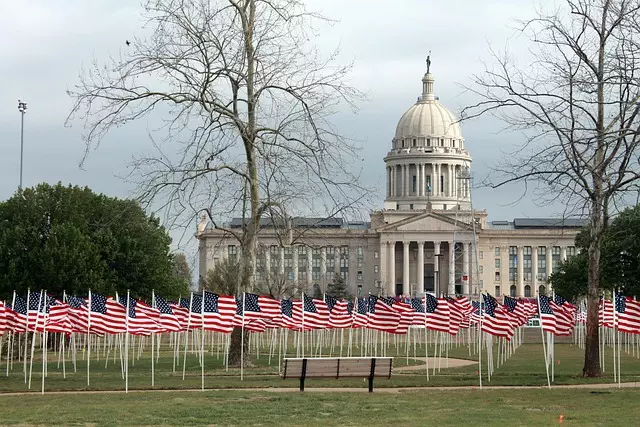Oklahoma's history is a mosaic of Native American roots, frontier tales, and significant 20th-century events, all of which are beautifully captured by the state's historical markers. These landmarks, highlighted in an Oklahoma travel guide as essential stops for any visitor, offer profound insights into key historical sites such as the Trail of Tears and the Greenwood District. They guide travelers through a tapestry of towns and landscapes, each with its own unique story to tell. The travel guide also points out the significance of the oil rush and Route 66, ensuring that your journey is enriched by Oklahoma's historical depth and cultural richness. For those interested in the state's heritage, these sites provide a deep dive into Oklahoma's past, including the Washita Battle Field National Historic Site and Fort Smith National Historical Site. These locations, among others, are part of the best places to visit in Oklahoma and offer things to do that are steeped in historical significance. They ensure that travelers not only see but truly understand the full narrative of Oklahoma's storied history. To fully appreciate Oklahoma's complex past, it's recommended to consult an Oklahoma travel guide and explore these sites, which tell a story of resilience, advancement, and the multifaceted heritage that defines the state.
Embark on a historical odyssey across Oklahoma with our comprehensive article, your essential Oklahoma travel guide to the state’s rich tapestry of heritage. From the rolling plains to bustling urban centers, Oklahoma’s best historical markers chart pivotal moments in its past. Explore top places teeming with significant landmarks that narrate tales from land runs to Native American history, offering a plethora of things to do in Oklahoma for history enthusiasts. Join us as we reveal the state’s notable historical markers and uncover treasures that define its legacy.
- Oklahoma Travel Guide: Discovering Historical Markers Across The State
- Charting Oklahoma's Past: A Guide to the Best Historical Markers
- Exploring Oklahoma's Rich History: Top Places with Significant Historical Markers
- From Land Runs to Native American Heritage: Things to Do at Oklahoma's Historic Sites
- Oklahoma's Treasures Unveiled: A Journey Through the State's Notable Historical Markers
Oklahoma Travel Guide: Discovering Historical Markers Across The State

Oklahoma’s landscape is a rich tapestry of history, culture, and natural beauty, making it an ideal destination for travelers seeking to immerse themselves in the past. An Oklahoma travel guide would be remiss without highlighting the state’s extensive network of historical markers that dot its land. These markers serve as gateways to understanding the diverse narratives that have shaped Oklahoma, from its indigenous heritage and frontier expansion to its pivotal role in the 20th century. For history enthusiasts and casual visitors alike, these signs are a treasure trove of information, often leading to some of the best places to visit in Oklahoma. From the site of the historic Trail of Tears to the Greenwood District, the markers tell tales of resilience and progress. Travelers can embark on a self-guided tour that takes them through towns and landscapes, each with its own stories to share. Things to do in Oklahoma are as varied as its history, with each marker offering a new perspective on the state’s past. Whether one is interested in the legacy of the oil boom or the remnants of Route 66, an Oklahoma travel guide points to these markers as not just stops on a journey, but as invitations to explore the depth and breadth of Oklahoma’s history, ensuring that every trip becomes a journey through time.
Charting Oklahoma's Past: A Guide to the Best Historical Markers

Oklahoma boasts a rich tapestry of history, with numerous historical markers that serve as testaments to its diverse past. Travel enthusiasts and history buffs will find the state’s historical markers an invaluable addition to any Oklahoma travel guide. These markers not only commemorate significant events but also highlight the contributions and cultural heritage of various groups who have shaped the region. For those seeking to explore the best places to visit in Oklahoma, these landmarks offer a glimpse into the state’s storied history, providing a sense of place and context that enhances the overall travel experience. From the site of the Green Corn Rebellion at El Reno to the Fort Smith National Historical Site, which straddles the Arkansas-Oklahoma border, each marker tells a unique story about Oklahoma’s evolution. Meanwhile, the Washita Battle Field National Historic Site offers insights into the fateful encounter between General Custer and Chief Black Kettle. These historical markers are not just relics of the past; they are tangible reminders of the events that have forged the state’s identity. When planning your Oklahoma journey, consider these historical landmarks as key attractions in your itinerary, offering a wealth of things to do in Oklahoma that go beyond the surface-level exploration of its cities and landscapes.
Exploring Oklahoma's Rich History: Top Places with Significant Historical Markers

Oklahoma’s landscape is dotted with historical markers that narrate a rich tapestry of history, making it an essential stop for history enthusiasts and casual visitors alike. An Oklahoma travel guide would be incomplete without highlighting these landmarks that offer a window into the state’s past. One of the most significant historical sites is the JFK Memorial Plaza in Dallas, Texas, just a short drive from the Oklahoma border. This site commemorates President John F. Kennedy and offers a sobering insight into a pivotal moment in American history.
For those exploring beyond this monument, the best places to visit in Oklahoma include the National Cowboy & Western Heritage Museum in Oklahoma City, which houses extensive collections of Western art and artifacts, offering an immersive experience into the heritage of the frontier era. Another must-visit is the Washita Battle Field National Historic Site near Cheyenne, where visitors can learn about the 1860s military campaign against the Southern Plains Indians. The Fort Smith National Historic Site in nearby Arkansas provides further context on the area’s role as a judicial and military outpost. These sites are just a snapshot of Oklahoma’s storied past and are among the many things to do in Oklahoma for those looking to delve into the state’s history. Travelers can use an Oklahoma travel guide to plan their journey through this historical landscape, ensuring they don’t miss these significant markers that tell the story of the region’s enduring legacy.
From Land Runs to Native American Heritage: Things to Do at Oklahoma's Historic Sites

Oklahoma’s storied past is a mosaic of pivotal events and rich cultural narratives that beckon visitors to explore its historic sites. For those following an Oklahoma travel guide, the state’s history unfolds through a series of land runs, which were rapid-fire openings of land for settlement, particularly in the late 19th century. These land runs are commemorated at sites like the Pawnee Bill Rodeo and Museum Complex, where reenactments and exhibits bring to life the frenetic energy of those historic moments. As part of the best places to visit in Oklahoma, these land run sites offer a glimpse into the courage and determination of early settlers.
Oklahoma’s heritage is as diverse as its landscapes, with Native American history deeply interwoven into the state’s narrative. The Washita Battle Field National Historic Site stands as a solemn testament to this legacy, marking the site where Lieutenant Colonel George Armstrong Custer and the 7th U.S. Cavalry attacked Chief Black Kettle’s Cheyenne camp on the Washita River in November 1868. Visitors can engage with interactive exhibits and embark on tours to learn about the significant events that shaped Native American history within Oklahoma’s borders. This site is not only a place for reflection but also an essential stop for those exploring things to do in Oklahoma that offer a deeper understanding of the state’s cultural tapestry. Whether tracing the footsteps of pioneers or delving into the heritage of Indigenous peoples, Oklahoma’s historic sites provide a multifaceted exploration of the region’s past, making it an enriching destination for any traveler following the best places to visit in Oklahoma as outlined in comprehensive travel guides.
Oklahoma's Treasures Unveiled: A Journey Through the State's Notable Historical Markers

Oklahoma’s landscape is rich with history, a tapestry woven through time by diverse cultures and significant events that have shaped its identity. For those intrigued by the state’s storied past, the historical markers serve as guiding beacons to a wealth of history waiting to be discovered. These markers are scattered across Oklahoma, each with its own story to tell. From the traverse of the ancient bison herds to the oil booms that have shaped its economy, these markers narrate tales of indigenous tribes, pioneering settlers, and pivotal moments in American history.
An Oklahoma travel guide is incomplete without highlighting the significance of these landmarks. They invite intrepid explorers to delve into the state’s heritage, offering a glimpse into the lives and traditions of the people who have called this place home. The Best places to visit in Oklahoma extend beyond the well-known routes; they include the forgotten trails, the silent stones marking the sites of ancient battles, and the monuments commemorating pioneering achievements in aviation and space exploration.
For history buffs and casual visitors alike, these markers are not mere relics but portals to understanding Oklahoma’s complex past. They serve as touchstones for the myriad stories that have unfolded across its vast plains and rolling hills. To truly experience Oklahoma is to walk in the footsteps marked by these historical signposts, engaging with the state’s rich tapestry of history. Things to do in Oklahoma often lead travelers to these markers, each offering a unique window into the state’s storied past, ensuring that every journey through this heartland state yields new discoveries and enlightening insights.
